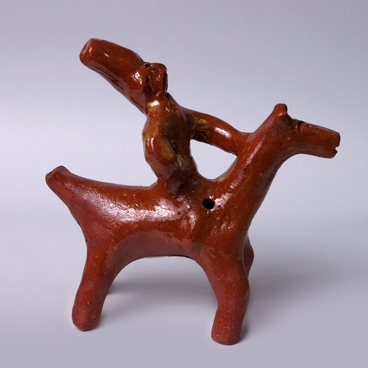The unusual toy from the museum’s collection was created in the late 20th century. The characteristic features of the Pleshkovo handicraft are clearly visible in the figurine: it is stable, symmetrical, and minimalistic. Traditionally, such figures were called “ladya"(a Russian boat) or ‘troika’ (a traditional Russian harness driving combination). Toys of the ‘Russian troika’ type consisted of two deer and a human figure between them, symbolizing the supreme deity Rod that managed the fate. Deer represented Rozhanitsy, goddesses of life and fertility and Rod’s daughters.
The “ladya” is considered a variation of the “Russian troika”. Horses were usually placed on the right and left sides symbolizing the rising and setting sun. They also stood for spring and autumn. The center could be occupied by other deities.
The toy from the museum’s collection shows a horseman with four arms. He hugs a fantastic creature by its two necks. The horse’s head looks to the left, the cow’s head with horns looks to the right. According to the folk tradition, the main purpose of such figures was to help people.
The Pleshkovo craft originated near the city of Oryol. The Oryol Oblast is famous for two areas engaged in making folk toys. One of them is the Chernysheno village which still exists today. The second one appeared in the village of Pleshkovo in the 17th century and became one of the oldest handicraft centers in central Russia. This village has not survived to this day, but the famous toy keeps the memory of it.
According to legend, there were continuous forests around the settlement, but due to the scarcity of land, a bald patch was formed in some places. This is where the name ‘Pleshkovo’ (Russian ‘plesh’ stands for ‘bald patch’ — ed.) came from. Those lands stored soft, pliant clay. The yellow clay was easily picked from the topsoil. The gray clay was right underneath, and the white clay with specks of shiny mica inclusions was stored in lower soil levels. The latter was especially easy to work with. When fired, it turned into a strong and dense ceramic with a pink tint.
The Pleshkovo people had long sculpted dishes on a potter’s wheel. Their canisters for milk and kvass were especially famous, while toys were made as a hobby. The toys could be painted in two color combinations — either red and green, or red and blue. The items' surface was usually covered with round and oval spots.
History has preserved the names of the original toymakers — Olga Malyutina and Alexandra Ivanilova. Nowadays, Ivanilova’s students — folk craftsmen Alexander Frolov, Natalia Frolova, and their children — carry forward the craft’s traditions. For generations, they have modeled toys of traditional shape with only slight modifications, so it is safe to say that the Pleshkovo clay toy managed to preserve its amazing simplicity and monumentality.
The “ladya” is considered a variation of the “Russian troika”. Horses were usually placed on the right and left sides symbolizing the rising and setting sun. They also stood for spring and autumn. The center could be occupied by other deities.
The toy from the museum’s collection shows a horseman with four arms. He hugs a fantastic creature by its two necks. The horse’s head looks to the left, the cow’s head with horns looks to the right. According to the folk tradition, the main purpose of such figures was to help people.
The Pleshkovo craft originated near the city of Oryol. The Oryol Oblast is famous for two areas engaged in making folk toys. One of them is the Chernysheno village which still exists today. The second one appeared in the village of Pleshkovo in the 17th century and became one of the oldest handicraft centers in central Russia. This village has not survived to this day, but the famous toy keeps the memory of it.
According to legend, there were continuous forests around the settlement, but due to the scarcity of land, a bald patch was formed in some places. This is where the name ‘Pleshkovo’ (Russian ‘plesh’ stands for ‘bald patch’ — ed.) came from. Those lands stored soft, pliant clay. The yellow clay was easily picked from the topsoil. The gray clay was right underneath, and the white clay with specks of shiny mica inclusions was stored in lower soil levels. The latter was especially easy to work with. When fired, it turned into a strong and dense ceramic with a pink tint.
The Pleshkovo people had long sculpted dishes on a potter’s wheel. Their canisters for milk and kvass were especially famous, while toys were made as a hobby. The toys could be painted in two color combinations — either red and green, or red and blue. The items' surface was usually covered with round and oval spots.
History has preserved the names of the original toymakers — Olga Malyutina and Alexandra Ivanilova. Nowadays, Ivanilova’s students — folk craftsmen Alexander Frolov, Natalia Frolova, and their children — carry forward the craft’s traditions. For generations, they have modeled toys of traditional shape with only slight modifications, so it is safe to say that the Pleshkovo clay toy managed to preserve its amazing simplicity and monumentality.
